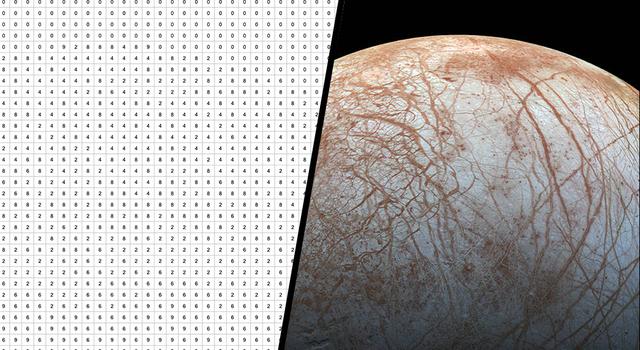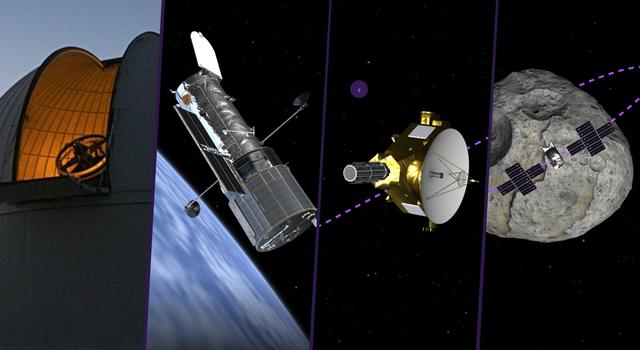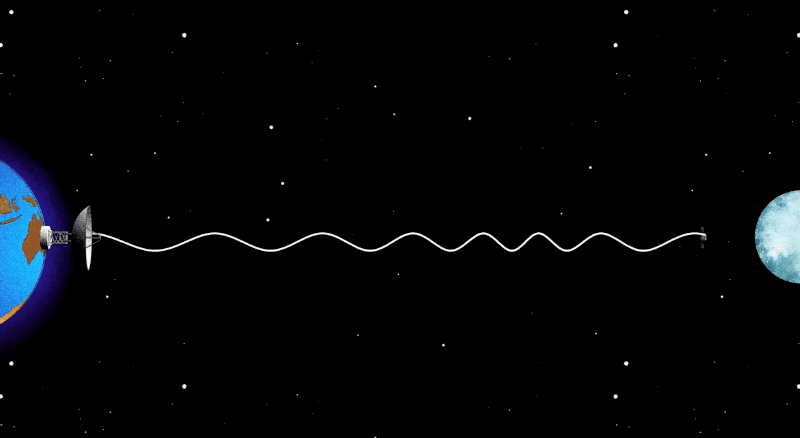Classroom Activity
Exploring the Doppler Effect With NASA
Overview
Students will gain first hand experience of the Doppler Effect for sound used by NASA’s Deep Space Network.
Materials
Management
- In advance of the lesson, build and test the Doppler ball:
This one-minute video covers the steps you'll need to build a doppler ball. See written instructions below.
- Use the wire strippers to remove a half inch of insulation from each lead wire on the buzzer and battery holder.
- Connect the buzzer to the battery holder by twisting together the exposed wire from the red leads. Use a small amount of electrical tape to secure and insulate the connection.
- Repeat step 2 for the black leads.
- If your battery holder has a power switch, make sure it’s in the “off” position.
- Insert the battery into the battery holder and close the lid.
- Turn the power switch on to verify that your buzzer sounds. It should be loud but not deafening.
- Using scissors, cut toward the center of the ball to create an opening for the buzzer. Be careful to not cut yourself.
- Insert the buzzer into the center of the ball.
- Wrap a heavy-duty rubber band or two around the ball to secure the opening so the buzzer will remain inside the ball when it’s thrown.
- Part of this activity requires students to throw a ball, which should either be conducted outdoors or in a safe indoor environment.
- The faster the ball is thrown, the easier it is to discern the change in pitch.
- If students cannot discern the change in pitch, skip to Step 6 and rotate the ball at sufficient speed for students to be able to hear the change.
- Students who are hard of hearing may have difficulty with this activity. Consider having them use a smartphone sound frequency analyzer app such as Phyphox to discern pitch differences.
Background
NASA’s Deep Space Network, or DSN, is an international network of antennae used to communicate with spacecraft. The DSN supports interplanetary spacecraft communication, radio astronomy, radar astronomy, and related space-science observations. It also supports some Earth-orbiting missions. The DSN consists of three antenna facilities spaced at roughly equal distances from each other (about 120 degrees apart in longitude) around the world, including:
- The Goldstone Deep Space Communications Complex near Barstow, California.
- The Madrid Deep Space Communications Complex near Madrid, Spain.
- The Canberra Deep Space Communication Complex near Canberra, Australia.
This interactive shows a real-time simulated view of communications between spacecraft and the DSN. Explore more on DSN Now.
The strategic placement of these sites permits uninterrupted communication with spacecraft as our planet rotates. Before a distant spacecraft sinks below the horizon at one DSN site, another site picks up the signal and carries on communicating. All three complexes consist of at least four antenna stations equipped with large parabolic dish antennas and ultra-sensitive receiving systems capable of detecting incredibly faint radio signals from distant spacecraft.
But the DSN is much more than a collection of big antennae. It is a powerful system for commanding, tracking, and monitoring the health and safety of spacecraft at distant locations throughout the solar system. The DSN also enables NASA scientists to perform powerful science investigations that probe the nature of asteroids and the interiors of planets and moons.
Watch this video to find out how we use the DSN to talk to spacecraft as they travel throughout the solar system. | Video transcript and related resources
Part of tracking and monitoring a spacecraft involves determining the spacecraft's speed using the Doppler effect. The spacecraft transmits a signal of known frequency. By tracking the apparent change between the transmitted frequency and the frequency of the signal received on Earth, we can tell whether the spacecraft is moving away from us or toward us and at what rate. If the received frequency is higher than the transmitted frequency, the spacecraft is moving toward us. If the received frequency is lower than the transmitted frequency, the spacecraft is moving away from us. This is an example of the Doppler effect on light waves that is often referred to as the Doppler shift because the frequency appears to be shifted along the electromagnetic spectrum.
Learn how we use the DSN to do radio and gravity science to explore the solar system and beyond. | › Watch on YouTube
The Doppler effect on sound waves is readily observable by students who have good hearing. The siren from a moving emergency vehicle or a train horn are good examples of the Doppler effect on sound-wave frequency, heard as a change in pitch. You can also demonstrate the Doppler effect in the classroom using a Doppler ball, as in this lesson.
Procedures
- Review the Doppler effect for sound with students:
- Discuss familiar examples such as the horn of a passing train or a passing emergency vehicle with siren.
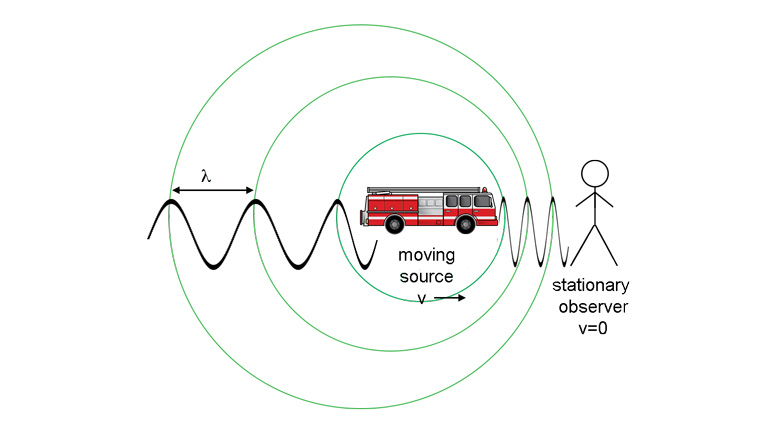
While the sound waves seem to bunch up for the observer as the firetruck approaches, notice that the frequency of the sound waves does not change. Image credit: NASA | + Expand image
- Explain that any wave phenomenon seems to "pile up" when moving toward an observer and "stretch out" when receding from the observer. This makes it seem to the observer as if the frequency has changed even though it has not. With sound, that means listeners hear an apparent change in pitch. With visible light, observers see an apparent change in color. With all kinds of light, there's an apparent shift toward the blue or red end of the spectrum. For example, some students may have heard of “red shift” as an indicator of the expansion of the universe.
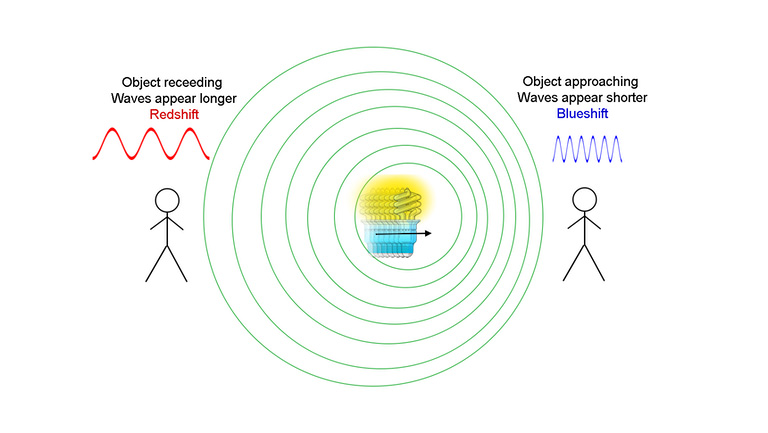
A light source moving away from the observer appears "redshifted" while a light source moving toward the observer appears "blueshifted." Image credit: NASA | + Expand image
- Discuss familiar examples such as the horn of a passing train or a passing emergency vehicle with siren.
- Share that the amount of Doppler shift is proportional to the line-of-sight velocity of the object, and light travel time tells us the distance to a spacecraft. These parameters assist in tracking and locating spacecraft in 3-D space.
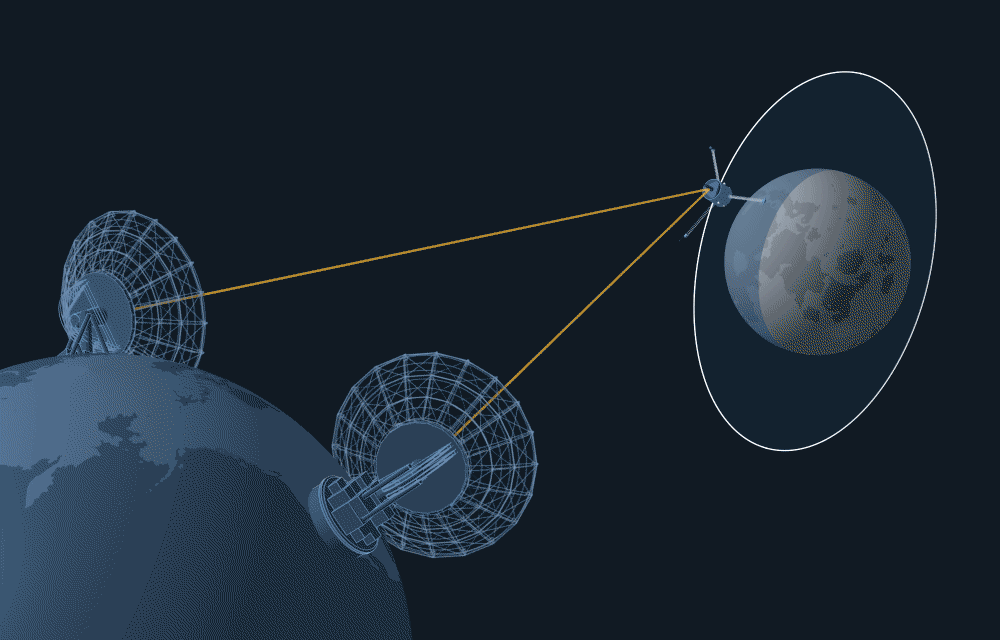
This animation shows how the DSN compares data obtained from multiple antennas to identify a spacecraft's position. Credit: NASA/JPL-Caltech | + Expand image
- Have students stand around the perimeter of the room, or take the class outdoors to form a large circle. Throw the Doppler ball to different students around the room, encouraging all students to listen with each throw.
-
Ask students to share what they noticed.
The amplitude (volume) change is apparent as the ball gets closer or farther, but the Doppler shift can also be very noticeable as the ball goes by students along the line of flight. Those off the line may notice a much diminished effect.
- Ask students to explain why students in the line of flight notice the Doppler shift more than those off the line of flight.
- Tie a one-meter length of string securely around the Doppler ball so the ball will not be at risk of coming loose when swung at high speed.
-
Resume the demonstration by orbiting the Doppler ball horizontally above your head, like a lasso, while you stand in the center of the circle formed by students. Ask students if they can hear a Doppler shift. Have them describe what they are hearing.
Most students with good hearing should be able to discern the shift in this circumstance even if they could not when the ball was being tossed.
-
Swing the Doppler ball in a vertical orbit, so that the orbital plane is perpendicular to the floor. Ask who can hear a Doppler shift.
Students in the plane of flight will be able to hear the Doppler shift, but the greater the angle between students and the plane of flight, the less they’ll be able to hear it. Ask students to hypothesize about why some students can hear it and some students now cannot.
- Remaining in the same location, rotate your body about 30 degrees to the right or left so the vertical orbit plane also shifts by that same angle. Orbit the Doppler ball in the new vertical orbit plane. Ask students who can discern a Doppler shift. Can the same students hear it, or are there different students who can hear it now? Ask students to confirm or revise their previous hypothesis.
- Repeat the step above several times until students are able to explain that being in the plane of orbit provides the most discernible Doppler shift. Being slightly out of plane provides a less obvious Doppler shift. Being perpendicular to the plane provides no Doppler shift.
- Explain that scientists can use this planar detection of the Doppler shift to determine a spacecraft's location in 3-D space. The change in frequency is a function of the angle between the line of sight and the line of motion. For trigonometry students, mention that the mathematics of this involves computing the cosine of the tilt angle. The cosine of 90 degrees is zero which explains why no Doppler shift is detectable at a perpendicular angle.
Discussion
- What is the Doppler effect?
- How do NASA scientists use the Doppler effect?
Assessment
During the lesson, observe students and listen to evaluate their knowledge of the relevant science concepts.
Extensions
- Learn more about how NASA tracks spacecraft with the Tracking Spacecraft with Trilateration lesson.
- Use the Doppler shift formula to find the velocity of a supernova in the Math of the Expanding Universe lesson.
- Have students record their knowledge of the Doppler effect in their science journals including illustrations.
- Within their science journals, have students record their experimental observations and hypotheses.
Explore More
-
 Collection
CollectionDSN Lessons for Educators
Explore STEM lessons for educators inspired by NASA's Deep Space Network.
-
 Collection
CollectionDSN Activities for Students
Explore STEM activites for students inspired by NASA's Deep Space Network.
- Article for Kids: Doppler Shift
- Resource: The Basics of Space Flight - The Doppler Effect
- Image: The Doppler Spike of Asteroid 2021 PJ1
- Article for Kids: How Does NASA Communicate With Spacecraft? | En Español
- Facts & Figures: About the DSN
- Interactive: DSN Now
- Downloads: DSN Posters
- Multimedia: NASA Deep Space Network: Celebrating 50 Years of Communication and Discovery





